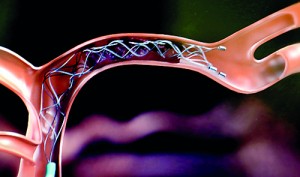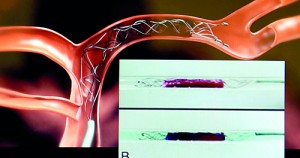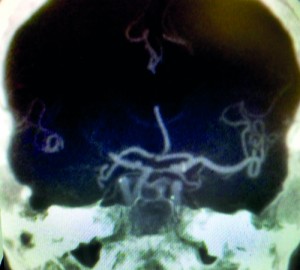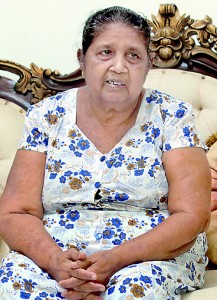News
Trailblazing clot-retrieval procedure saves septuagenarian’s life
She walks gingerly down the steps of her daughter’s home at Battaramulla, giving us a big smile.
Princy Perera, 76, has had a close-call and as her daughter Mangalika Ranaweera looks at her, she shudders at the thought of “what might have been”.What might of have been is incapacitation through paralysis due to a massive stroke 19 days ago on March 12. A stroke occurs when blood flow to the brain stops due to a clot in a vessel or the rupture of a vessel causing haemorrhage.

How the procedure is performed
But Princy is now fine and back to her routine due to a wonder procedure that was carried out for the first time in Sri Lanka at the Central Hospital in Colombo 10.
It is trailblazing mechanical clot-retrieval through a minimally-invasive procedure, the Sunday Times learns. Brief the procedure was, lasting just about 15 minutes.
When Mangalika rushed her mother to the Central Hospital on finding her fallen to a side in her chair, she did not know anything about this procedure. She recalls the shock of seeing her mother not only incoherent, but also with her mouth gone to a side unable to talk and her left side paralysed unable to walk, that afternoon.
At the hospital, Mangalika remembers how things happened quickly. The staff at the Emergency Treatment Unit (ETU) responded promptly and worked to a very efficient protocol. When she requested that they call her mother’s Consultant Physician, Dr. Tissera, they did that.
 The protocol has been introduced by Stroke Physician, Dr. Thurul Attygalle, and on the request of Dr. Tissera that he attend to the patient, the staff had got into gear with military-style precision.
The protocol has been introduced by Stroke Physician, Dr. Thurul Attygalle, and on the request of Dr. Tissera that he attend to the patient, the staff had got into gear with military-style precision.
By the time Dr. Thurul came in a little while later, blood tests and even the CT scan to identify what type of stroke it was had been carried out.
It was an ischaemic stroke (where a clot blocks a vessel taking blood to the brain), says Dr. Thurul. The blocked vessel was the main middle cerebral artery on the right side of the brain. This is why Princy had become paralysed on the left side of her body.When a patient has suffered an ischaemic stroke, the first-line of treatment is the infusion of the clot-busting drug, says Dr. Thurul, but they had their suspicions that it may not be the only answer as the clot was large.With the multidisciplinary team which handles stroke coming to a decision that the need of the moment to prevent permanent paralysis was clot-retrieval, the scene then changed from the ETU to the Catheterisation Laboratory or the Bi-plane Digital Subtraction Angiography (DSA) Unit.Not even awaiting the elevator, the two Consultant Interventional Radiologists, Dr. Nihal Wijewardena and Dr. Lakmalie Paranahewa took the stairs, says Mangalika.
“Usually when you administer the clot-buster, there is some improvement in the patient within about one hour,” says Dr. Lakmalie, adding that because in Princy there was not much of an improvement, a contrast-enhanced CT-angiogram was performed which detected a complete occlusion (block) of the artery.
It was in the Cath Lab that Princy was put under General Anaesthesia and the procedure performed.
“We accessed the blocked vessel through a right femoral puncture,” says Dr. Lakmalie, explaining that they then passed the wire across the blood clot into the distal vessel, after which followed the catheter. Then a retrievable stent was deployed across the clot.
The moment the stent was placed, the blood starts to flow through the block immediately, she says.
When the stent was retrieved with the clot, the blood flow was fully restored, it is learnt, which means that a total re-canalisation of the vessel had taken place.

Princy Perera: Back to her routine. Pix by M.A. Pushpa Kumara
Explaining the scenario in greater detail, Dr. Thurul says that the onset of the stroke had been at

Dr. Thurul Attygalle
around 4.30 p.m. Fortunately, the family acted promptly and brought her to hospital within the golden time-frame. The clot-buster administered to her did not dissolve the clot fully — it got smaller but did not go away completely.
After the procedure, Princy was off sedation by about 8.30 p.m. and the doctors were thrilled to see her moving her left hand and leg soon after.
She was then moved to the Neuro Intensive Care Unit where she was kept for a day and then to the ward. The satisfaction of the team can only be imagined when Princy began walking in the ward. She went home on March 17.
In January, the clot-busting treatment had been administered to another patient who had also gone home after complete recovery.

Dr. Lakmalie Paranahewa
The team which performed the pioneering mechanical clot-retrieval procedure in Sri Lanka included Consultant Neurosurgeon Dr. Sunil Perera; Consultant Neurologist Dr. Senaka Bandusena; Consultant Anaesthetist Dr. B.P.K. Pethangoda; and Consultant in Transfusion Medicine Dr. Gamini Jayaweera, supported by the staff of the Radiology Department and Cath Lab. The post-procedure management was by the ICU staff.


